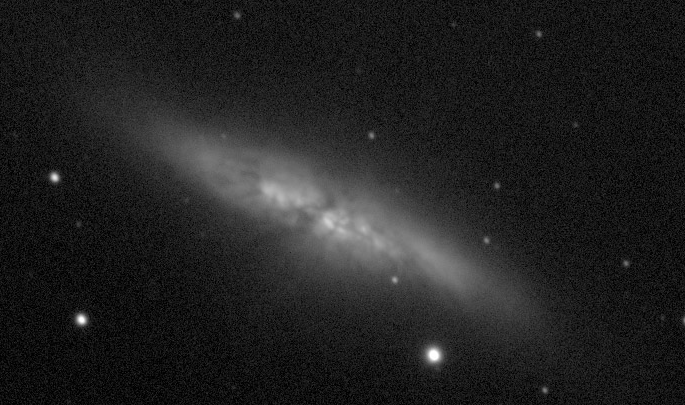Supernova!
 |
| Animation showing SN 2014J |
Around January 19th a new supernova was detected in the night sky. Dubbed SN 2014J, the supernova is visible from the northern hemisphere in M82, a galaxy in the constellation Ursa Major. Consider, M82 is 12 million light years away so this explosion actually happened 12 million years ago but it has taken the light that long to travel the distance between our galaxies. 12 million years ago our Earth was in what is now called the Serravallian stage of the Miocene geological epoch. While humans did not yet exist at the time of the explosion the Earth was populated by a diversity of life including apes which were widespread.
I set out to observe the new-to-us supernova the first clear night after it's announcement. I've looked at M82, also called Bode's Nebulae or the Cigar Galaxy, many times. It's one of my favorites and I am familiar with it. It is an elongated galaxy with more visual definition than most galaxies. In dark skies with a telescope of 8" or greater it is possible to see the mottling of dust and gas. I saw the supernova immediately as it appeared to be a tiny star in the lower part of the galaxy. To a casual observer it would not appear to be much other than a small and faint star not unlike many of the smaller and fainter stars in our own Milky Way galaxy. But this is not a star in our galaxy.
Let me offer some perspective. Our Milky Way is an estimated 100,000 light years in diameter. Most of the stars we see with the unaided eye are 10,000 light years or less in distance. The most distant we can see unaided is about 15,000 light years away. Most of what we see is a good deal closer than that. Now, to reiterate, this supernova is 12 MILLION light years away and yet we can see it as a distinct point of light. That must have been one magnificent event and when it happend humans did not yet exist on Earth. But our curious species does exist today and we have been around long enough that we have telescopes to observe as well as the science needed to understand it. When the light from this event reached us we were ready for it.
Astronomers classify this kind of supernova as a type Ia. Essentially, when stars the size of our sun have exhausted their hydrogen and helium fuel (after 10 billion years or so) they collapse in on themselves to something much smaller and more dense. We call this kind of collapsed star a white dwarf and they have a mass comparable to that of the Sun, but a volume comparable to that of the Earth. At this point the star is no longer undergoing the nuclear fusion of gas but is just radiating lots of heat into space and will do so for trillions of years. However, if the white dwarf had a companion star it might, thanks to gravitation, begin pulling off gas from that star. If this goes on long enough the white dwarf will form an accretion disk of gas around itself and as the gas accumulates it builds in pressure and density due to the increasing weight which raises the temperature of the core. When the star nears a size of about 1.44 solar masses a period of convection begins and then ignition. Because white dwarfs do not regulate the fusion process as normal stars do, ignition results in runaway fusion reaction. Much more detail about the process is available via this page at Wikipedia.